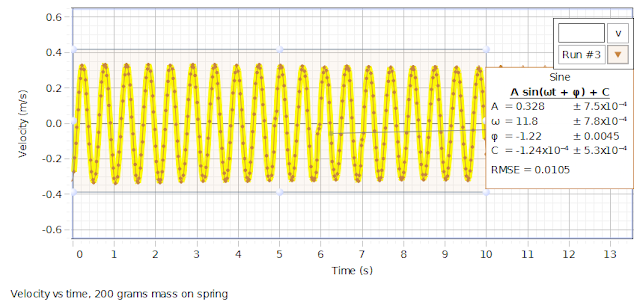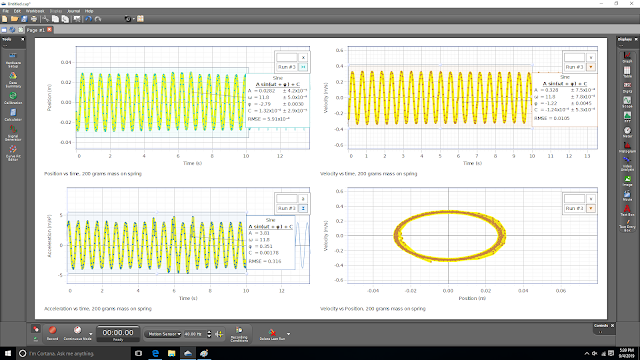The ballistic pendulum is a well-known apparatus in introductory physics courses. It is commonly used to illustrate some conservation laws:
- momentum conservation (before and after the projectile impacts the arm)
- energy conservation (after impact while swinging to its apex, and also during the firing sequence).
The second set of conservation laws--energy conservation--are generally agreed upon. The first set set--momentum conservation--are not exactly contested. However, some courses will present this as an angular momentum conserving collision, while others will present it as a linear-momentum conserving collision. It is my purpose to note briefly that the former can be approximated by the latter, if some appropriate conditions are met.
First, I should note that a series of articles appearing in
The American Journal of Physics have shown that this is in fact an angular-momentum conserving collision, and that in fact linear momentum as such is not conserved. This was first noted by T.R. Sandin [
1], and then again expanded upon by A. Sachs [
2], by Enos Wicher [
3], and by P.D. Gupta [
4]. Sachs in particular found that linear momentum conservation works as a good approximation, to within a factor of R'/R, where R is the distance from pivot point to ball center of mass and R' is the radius of gyration for the ball and pendulum system. Thus, the muzzle velocity of the projected ball is predicted by linear momentum conservation to be
\$v = \frac{m+M}{m} \sqrt{2gh} \$
where m is the mass of the ball and M the mass of the pendulum arm. However, the actual muzzle velocity is in fact given by
\$v = \frac{m+M}{m} \sqrt{2gh} \frac{R'}{R} \$
For the bob-catcher on a rigid arm pendulum used by Sachs, this resulted in a ratio R'/R = 0.96, that is, the linear momentum conservation overestimates the muzzle speed by approximately 4%.
Gupta performed a further experiment in which a massive sleeve could be mounted to the rigid arm and fixed at different positions along the pendulum arm, thereby changing the moment of inertia but not the total mass of the pendulum. He found that the muzzle speed determined from linear momentum conservation exceeded the value determined by angular momentum conservation by as much as 12% for the ball-pendulum-sleeve-gun system used, and that in all cases the angular momentum conservation value more nearly matched the value obtained by measuring range for a fixed drop distance from the same gun. In other words, the conservation of angular momentum is the more accurate principle for modelling this interaction, and it actually tended to get the "correct value" of the muzzle speed within the margin of error of the experiment.
This brings us back to the question, is it wrong to use the conservation of linear momentum in discussing the ballistic pendulum experiment? Well, it depends on how accurate you want your results to be, and how dynamic (e.g. will you be changing the mass configuration of the pendulum?). We can use the conservation of linear momentum if we modify some terms, slightly. Consider the collision in question: a ball of mass m collides with and sticks to a pendulum of moment of inertia I at a point a distance R from the pendulum's axis of rotation (e.g. pivot point). We take the ball's radius r to be negligible, e.g. r<<R so the ball will act like a point mass. Our conservation laws give:
Angular Momentum, \$m R v_1 = m R v_2 + I \omega \$
Energy, \$ \frac{1}{2}m v_2 ^2 + \frac{1}{2} I \omega ^2 = (m + M \frac{R_cm}{R} ) g \Delta h \$
where M is the mass of the pendulum. We can, moreover, relate the angular speed of the pendulum to the instantaneous linear (tangential) speed of the ball after impact: \$ v_2 = R \omega \$ . Thus, our conservation conditions become
Angular Momentum, \$m R v_1 = m R v_2 + \frac{I}{R} v_2 \$, which can be solved for \$v_1 \$ to give \$v_1 = \frac{m + I/R^2 }{m} v_2 \$
Energy, \$ \frac{1}{2}m v_2 ^2 + \frac{1}{2} \frac{I}{R^2} v_2 ^2 = (m + M \frac{R_cm}{R} ) g \Delta h \$
We now note that the \$I/R^2 \$ term has the same dimension as a mass, and indeed we can define it as the effective mass \$ M_{eff} \$ of the pendulum: this is the mass which, if reduced to a point and placed at the location of the impact, would have the same moment of inertia as the pendulum itself. The term \$ \frac{R_cm}{R} M \$ also has this form of an effective mass, and in fact is the same effective mass as found for the moment of inertia. By combining the two conservation conditions and solving through for the muzzle speed \$v_1 \$, we finally obtain
\$v_1 = \frac{m + M_{eff} }{m} \sqrt{2 g \Delta h } \$
Which is essentially the same equation we obtained for the muzzle speed using linear momentum conservation.
---
References (articles linked in citation numbers, but they are mostly behind a paywall)
[
1] T.R. Sandin, "Nonconservation of Linear Momentum in Ballistic Pendulums,"
American Journal of Physics, vol.
41 no. 3, 426-427 (1973).
[
2] A. Sachs, "Blackwood pendulum experiment revisited,"
American Journal of Physics, vol.
44 no. 2, 182-183 (1974).
[
3] Enos Wicher, "Ballistics pendulum,"
American Journal of Physics, vol.
45 no 7, 681-682 (1977).
[
4] P.D. Gupta, "Blackwood pendulum experiment and the conservation of linear momentum,"
American Journal of Physics, vol.
53 no. 3, 267-269 (1985).















 , so the sound wave intensity should be linearly proportional to the ambient pressure: we expect I = a P, where P is the pressure and a is a constant which accounts for frequency, amplitude, speed, etc. Thus, doubling the pressure of the chamber should double the intensity of the sound emitted from a speaker, assuming no other changes.
, so the sound wave intensity should be linearly proportional to the ambient pressure: we expect I = a P, where P is the pressure and a is a constant which accounts for frequency, amplitude, speed, etc. Thus, doubling the pressure of the chamber should double the intensity of the sound emitted from a speaker, assuming no other changes.







